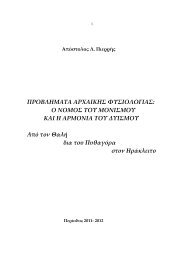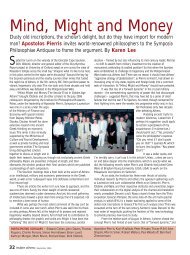22something whose immediate product, and, so to speak, reflecti<strong>on</strong>, <strong>the</strong> immanentorder (and hence <strong>the</strong> field as a certain determinate field) is. In this way, we raiseabove <strong>the</strong> ὁμοταγῆ (things which co-bel<strong>on</strong>g to a certain order) <strong>the</strong> principle <strong>of</strong> <strong>the</strong>m;this does not have <strong>the</strong> c<strong>on</strong>nectedness displayed by <strong>the</strong> ὁμοταγῆ, this lacks <strong>the</strong>ir way<strong>of</strong> <strong>on</strong>tologically referring to each o<strong>the</strong>r, and is so, in virtue <strong>of</strong> <strong>the</strong> said <strong>the</strong>orem,“higher” from <strong>the</strong>m , lying “above” <strong>the</strong>m . But though this principle (and here weprepare for <strong>the</strong> sec<strong>on</strong>d stage <strong>of</strong> <strong>the</strong> applicati<strong>on</strong> <strong>of</strong> <strong>the</strong> <strong>the</strong>orem) is immune from <strong>the</strong>inter-referring <strong>of</strong> <strong>the</strong> items bel<strong>on</strong>ging to <strong>the</strong> field whose principle it is, yet is notcompletely absolved from any referring whatsoever; for if a principle, it is a principle<strong>of</strong> something , if higher, it is higher than something; if first, it is first withreference to what follows it , if a cause, it is a cause <strong>of</strong> <strong>the</strong> caused thing .Thus reference-being still inf ests such principles as are seen through <strong>the</strong> firstapplicati<strong>on</strong> <strong>of</strong> our <strong>the</strong>orem. We thus, again in c<strong>on</strong>formity to it, must pose that whichis totally immune from any reference, relati<strong>on</strong> or c<strong>on</strong>necti<strong>on</strong> and co-ordinati<strong>on</strong>whatsoever; and as <strong>the</strong> One, which is high er [51] than everything else, has thatrelati<strong>on</strong>ship to be higher than, and a principle <strong>of</strong>, everything else and thus thisminimal co-ordinati<strong>on</strong> with everything else; so that reality which our sec<strong>on</strong>dapplicati<strong>on</strong> <strong>of</strong> <strong>the</strong> aforementi<strong>on</strong>ed <strong>the</strong>orem requires, must b e above and bey<strong>on</strong>d <strong>the</strong>One with an above-ness and bey<strong>on</strong>d-ness which transcends any c<strong>on</strong>ceivable andformulable above-being or bey<strong>on</strong>d-being [52].We shall compare in detail this doctrine with that <strong>of</strong> Proclus later, whenenough material has been ga<strong>the</strong>red from D.’s development. But we may point here,preliminarily, its metaphysical significance.Suppose, for brevity ’s sake, that two reality-c<strong>on</strong>tents X and Y are mutuallyexclusive and jointly exhaustive in a certain field, in <strong>the</strong> sense that any itembel<strong>on</strong>ging to <strong>the</strong> field must be ei<strong>the</strong>r X or Y, but cannot be both; suppose also that<strong>the</strong>y essentially divide <strong>the</strong> given field between <strong>the</strong>m, i.e. <strong>the</strong>y are not merelyaccidental properties <strong>of</strong> what bel<strong>on</strong>gs to <strong>the</strong> field. By field we mean a system <strong>of</strong> itemsobeying a certain order, this obeying being c<strong>on</strong>stitutive <strong>of</strong> it as that specific field, i.e.an essentially co-ordinated system <strong>of</strong> items. Since X and Y pertain essentially to <strong>on</strong>eand <strong>the</strong> same field, <strong>the</strong>y <strong>the</strong>mselves are ὁμοταγῆ, coordinated, <strong>the</strong>y are <strong>on</strong> <strong>the</strong> samelevel, namely that <strong>of</strong> <strong>the</strong> field in questi<strong>on</strong> (which may be picturesquely portrayed as ahoriz<strong>on</strong>tal cut <strong>of</strong> reality). Hence, <strong>the</strong>y cannot be c<strong>on</strong>nected as <strong>the</strong> primary to <strong>the</strong>
23sec<strong>on</strong>dary, as <strong>the</strong> eminent to <strong>the</strong> inferior (in degree or kind), as <strong>the</strong> possessi<strong>on</strong> to <strong>the</strong>privati<strong>on</strong>: <strong>the</strong>y are ra<strong>the</strong>r both positive natures, perfected to <strong>the</strong> same degree each inits own kind and manner, pitched, as it were, <strong>on</strong>e against <strong>the</strong> o<strong>the</strong>r <strong>on</strong> <strong>the</strong> samet<strong>on</strong>e; <strong>the</strong>y corresp<strong>on</strong>d to each o<strong>the</strong>r, <strong>the</strong>y are not subordinated <strong>the</strong> <strong>on</strong>e to <strong>the</strong> o<strong>the</strong>r.The field, qua <strong>the</strong> field which it is, must have a transcendent principle, <strong>the</strong>cause <strong>of</strong> its immanent principle <strong>of</strong> ordering. And since X and Y essentially divide <strong>the</strong>field, being thus a cardinal comp<strong>on</strong>ent <strong>of</strong> <strong>the</strong> prevai ling order, <strong>the</strong>ir so doing, and<strong>the</strong>refore <strong>the</strong>ir natures enabling <strong>the</strong>m to so do, must equally well proceed from <strong>the</strong>said principle. This principle being bey<strong>on</strong>d <strong>the</strong> initial field, and thus exempt from <strong>the</strong>order which it creates, cannot be ei<strong>the</strong>r X or Y. X an d Y, as disjoint but c<strong>on</strong>nectedreality-c<strong>on</strong>tents, appear for <strong>the</strong> first “time” in <strong>the</strong> chain <strong>of</strong> reality o n <strong>the</strong> level <strong>of</strong> thatinitial field . But still <strong>the</strong>y must come from somewhere; and, fur<strong>the</strong>r, <strong>the</strong>y mustalready be in that from which <strong>the</strong>y come in order to be able to come at all andmanifest <strong>the</strong>mselves primarily and for <strong>the</strong> first “time” in <strong>the</strong> said field [53].C<strong>on</strong>sequently, since <strong>the</strong> principle <strong>of</strong> <strong>the</strong> field must be X and Y, but cannot be so in<strong>the</strong> divided way in which <strong>the</strong> field itself is X and Y, it must be X a nd Y in anundivided fashi<strong>on</strong>, it must possess X and Y in <strong>the</strong>ir unity which is seen thus to bepresupposed by <strong>the</strong>ir separated subsistence. X and Y, we said, are present in <strong>the</strong>initial field as divided by intrinsically c<strong>on</strong>nected reality-c<strong>on</strong>tents; here, in th e principle<strong>of</strong> <strong>the</strong> field, <strong>the</strong> divisi<strong>on</strong> disappears, and <strong>the</strong> intrinsic c<strong>on</strong>necti<strong>on</strong> is transformed intoundivided unitedness, which is really but <strong>the</strong> cause <strong>of</strong> <strong>the</strong> c<strong>on</strong>nected separatedness.So we have <strong>the</strong> field, whose formal expressi<strong>on</strong> (in so far as its structur e isc<strong>on</strong>cerned, and with reference to what was assumed as an essential feature <strong>of</strong> thatstructure, namely <strong>the</strong> specific interc<strong>on</strong>nectedness <strong>of</strong> X and Y), may be given as“ei<strong>the</strong>r X or Y ”. And we have <strong>the</strong> field ’s principle, whose corresp<strong>on</strong>ding formalexpressi<strong>on</strong> we saw must be “both X and Y ” [54]. Is <strong>the</strong>re anything else in <strong>the</strong>present c<strong>on</strong>necti<strong>on</strong> to which we must proceed in however dark a way?D.’s c<strong>on</strong>tenti<strong>on</strong> is that <strong>the</strong>re is; that bey<strong>on</strong>d <strong>the</strong> principle which is both X and Yat <strong>on</strong>ce, <strong>the</strong>re must be ano<strong>the</strong>r which can be said to be nei<strong>the</strong>r X , nor Y, nor even Xand Y, which <strong>the</strong>refore, in a certain sense must be nei<strong>the</strong>r X nor Y , exhaustivethough X and Y are, as we assumed at <strong>the</strong> beginning. Three reas<strong>on</strong>s are given herefor this necessity – but <strong>the</strong> significance will gradua lly become more and fuller and
- Page 2 and 3: 2GENERAL REMARKThe first section is
- Page 4 and 5: 4Four reasons are, in aporematic fa
- Page 6 and 7: 6ὐθύς, i.e. without any prior
- Page 8 and 9: 8ἀμερές). Thus nothing is mi
- Page 10 and 11: 10separate them. Basically, as Aris
- Page 12 and 13: 12produced by, it; the principle in
- Page 14 and 15: 14the fashion of its one-ness, i.e.
- Page 16 and 17: 16[36] it may be. Now the def inite
- Page 18 and 19: 18found, and (there found) in accor
- Page 20 and 21: 20in its elf (apart from the orderi
- Page 24 and 25: 24clearer, as the system is further
- Page 26 and 27: 26ἡνωμένον, which generate
- Page 28 and 29: 28We find in this here a good insta
- Page 30 and 31: 30fully see his point, and to take,
- Page 32 and 33: 32NOTES[1] Not quite “given” th
- Page 34 and 35: 34forget that, for the time being,
- Page 36 and 37: 36[28] The interpretation given to
- Page 38 and 39: 38[39] It can be shown that there c
- Page 40 and 41: 40being immersed in it, handling it










